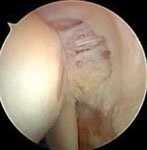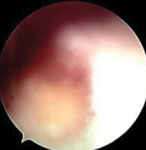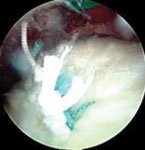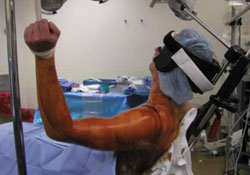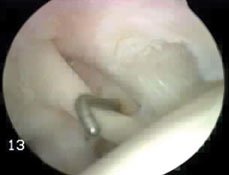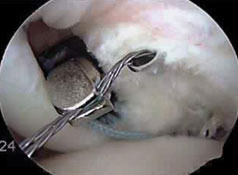Partial rotator cuff tears: When is surgery indicated?
by William N. Levine, MD
Although the main treatment option for partial thickness rotator cuff repair is nonoperative treatment, especially for the throwing-athlete, there are occasions when surgical treatment is the preferred course.
We have learned a lot about rotator cuff tears over the past several decades. From cadaveric studies we know that they are very common, about one-third of cadavers studied had a partial thickness tear. We know from Payne’s work that they are typically on the articular side compared to the bursal side. We also know that overhead athletes as a subset, need to be viewed completely differently — 40% of these asymptomatic athletes had either partial of full-thickness tears compared to none in their nondominant shoulders, according to Connor and colleagues. So if you get an MRI on an overhead athlete, you can expect there will be a good chance of a cuff problem.
The question is what do you do with that information?
|
|
Tear grades
Harvey Elman first introduced the classification that many still use today: Grade 1 for tears less than 3 mm; grade 2 for tears 3 mm to 6 mm; and grade 3 for those greater than 6 mm. The other way to think about these injuries are to consider them as “high-grade” (greater than 50% thickness) or “low-grade” (less than 50% thickness).
Partial tears can be further classified as articular-sided or bursal-sided tears, where the medial footprint is intact and you can only see it from the bursal side.
In 2001, Snyder introduced the partial articular surface tendon avulsion (PASTA) lesion, and Conway added partial thickness articular surface intra-tendinous (PAINT) tears, a specific tear pattern seen in overhead athletes in which the footprint is usually intact but it is an extension of a tear that is intra-laminar, starting at the posterior part of the supraspinatus and often going into the infraspinatus.
You have to understand the type of patient you are treating and that will dictate which type of repair that is appropriate.
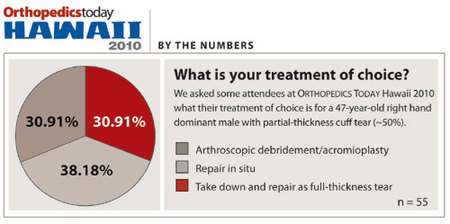
Know your patient
Partial tears in throwers are different and cannot be managed the same as in the non-throwing population. If you perform a tendon-to-bone PASTA repair in a 23-year-old, that will likely lead to loss of terminal external rotation and they probably won’t return to their desired level of performance.
The physical exam for partial tears is challenging as there is not one test that will be diagnostic. The Jobe relocation for internal impingement can be helpful. That will cause pain, not apprehension, when the arm is in the hyper-extended, abducted externally rotated position. That pain will go away when the arm is brought in front of the body. Instability testing should be performed in all of these patients - although they may not have them - and of course a SLAP examination should always be performed as these lesions are often found in conjunction with a partial cuff tear in the overhead athlete.
|
|
|
|
|
For the procedure, Levine identifies the partial tear (left), assesses the footprint down to the bone to evaluate the possibility of completing the tear (center) and then places a marking suture that will aid in assessing the bursal side of the tear (right). Images: Levine WN |
||
These patients, who tend to be younger and participate in overhead sports, may or may not have external impingement signs. Selective injections into the subacromial space (external impingement) or into the glenohumeral joint (internal impingement) can be helpful to differentiate where their pain is coming from in unclear situations.
Surgical indications
Surgery is usually indicated if the patient’s pain is not relieved by 3 to 6 months of nonoperative treatment, including activity modification — avoidance of overhead or pain-provoking actions — NSAID use, physical therapy, strengthening, and subacromial or glenohumeral steroid injections.
There are several surgical options including: 1) debridement in isolation; 2) debridement with an acromioplasty; or 3) rotator cuff repair.
There are three options for managing the cuff. The partial-tear can be converted to a full-tear and repaired; a trans-tendon in-situ repair can be performed (which would be considered for a PASTA lesion in a non-throwing athlete); or an intra-laminar repair for the athlete who has an intact footprint — the so-called PAINT lesion.
|
|
|
The technique
Should you take down intact tendon and then repair the entire tendon, do a trans-tendon in-situ repair, or perform an intra-laminar repair for throwers?
Completing the tear involves the excision of potentially normal tissue — so the question that needs to be asked is how “high-grade” is the tear. Knowledge of the normal footprint anatomy helps to determine the “grade” of involvement since the supraspinatus medial-lateral footprint is 12 to 16 mm. Therefore, if there is 6 to 7 mm of intact tendon, we consider it a high-grade tear?
First, I identify the articular-sided tear by probing the defect to get a sense of how deep the tear is. Assess the footprint for exposed bone and if there is too much exposed it is safer and more reliable to just convert to a full thickness tear. Since most probe tips are 3 mm, it is fairly straightforward to determine the depth of the tear.
An important step at this point is to percutaneously place a marking suture which will allow bursal side assessment of the tear.
|
|
|
Bursectomy
A technical pearl at this point is to do a thorough bursectomy so when you go back to repair the tear it will be easier to find your sutures. This is also a good time to assess the tendon and to see if there is any communication to the bursal side.
Then footprint abrasion should be performed to enhance the healing. Suture anchors can then be placed through the intact bursal-side tendon (trans-tendon) and the type of anchor is surgeon dependent (bioabsorbable, PEEK, or metal).
|
|
Suture management
In terms of suture management, it is always best to have two different color sutures. By routine I use the blue suture anteriorly and a striped suture posteriorly to assist in suture management.
I use a percutaneously placed suture shuttle device, although a number of different devices including a spinal needle can be used. The typical repair strategy is to use one anchor and one suture from each pair is placed through the medially retracted articular tear. Then I test the repair by pulling all four sutures — if the sutures have been appropriately placed — the medial row should anatomically reduce. If the medial row does not reduce, however, the other two limbs should also be placed through the articular tissue and then this pre-suture tying step should be re-checked.
Then attention is re-directed to the subacromial space and because a thorough bursectomy was previously performed, clear visualization of the sutures is enhanced and the sutures are retrieved and tied. It is important to go back into the joint to make sure the repair is anatomic. This is also a good time to check for synovitis that has been pulled laterally now that an anatomic repair has been performed.
The PAINT repair uses all the same technical aspects, but suture anchors are not used so it’s basically a soft tissue repair.
References
- Conway JE. Arthroscopic repair of partial-thickness rotator cuff tears and SLAP lesions in professional baseball players. Orthop Clin North Am. 2001;32(3):443-456.
- Ellman H. Diagnosis and treatment of incomplete rotator cuff tears. Clin Orthop Relat Res. 1990;254:64-74.
- Payne LZ, Altcheck DW, Craig EV, Warren RF. Arthroscopic treatment of partial rotator cuff tears in young athletes. A preliminary report. Am J Sports Med. M1997;25(3):299-305.
- William N. Levine, MD, professor of orthopedic surgery and chief of sports medicine, can be reached at Columbia at New York-Presbyterian Hospital, 622 West 168th St., PH 11, New York, NY, 10032; 212-305-0762.; e-mail: wnl1@columbia.edu.


